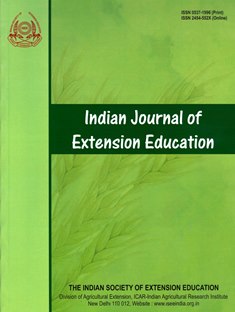Situation Analysis of Small-scale Mushroom Enterprises of Meghalaya in the Wake of COVID-19 Pandemic
DOI:
https://doi.org/10.48165/IJEE.2023.59115Keywords:
Mushroom, COVID-19, SWOT, TOWS and Enterprises, MeghalayaAbstract
As a remunerative agri-business, mushroom farming is growing as an alternative source of income for the rural population. Meghalaya has climate highly suitable for mushroom cultivation and thus the Government of Meghalaya has taken up various interventions to popularize mushroom cultivation. The study was taken up in the East Khasi Hills and Ri-Bhoi districts of the state during 2020-2022 to analyse the situation of the mushroom enterprises in the wake of the COVID-19 pandemic, which impacted people and businesses all throughout the world. SWOT analysis and TOWS matrix were used for analysing the internal and external factors. The perceptions of 60 growers towards selected SWOT items were recorded. Important strength item was “climatic condition is congenial for mushroom” and the weaknesses was “restriction as well complexity in the mobility of the goods and persons”. For opportunities, “generates employment opportunities” had the highest score and for threats, “Unavailability of spawn” had the highest score. The study suggests establishment of mushroom based FPOs for ease of access to inputs and market for small-scale producers, the development of local spawn entrepreneurs for the accessible and timely supply of quality spawn and the creation of ICT based platform for reaching out to various backward and forward actors.
Downloads
References
Athuraliya, A. (2022, August 16). The easy guide to performing an effective situation analysis. The Creatly Blog. https:// creately.com/blog/diagrams/what-is-a-situation-analysis/
Biswas, S. (2018, April 4). The myth of the Indian vegetarian nation. BBC News. https://www.bbc.com/news/world-asia-india 43581122
Citraresmi, A. D. P., Haryati, N., & Permanasari, P. N. (2021). Identifying elements of mushroom business development in Malang City with a Canvas model approach. Advances in Food Science Sustainable Agriculture and Agroindustrial Engineering, 4(1), 39-47.
Datta, P., & Das, S. (2019). Model based strategic planning for strengthening mushrooms entrepreneurship: insights from a sub Himalayan Region of West Bengal. India. Geo Journal, 86, 145-158.
Filipov, M. N. (2021). Social media marketing for small and medium sized enterprises in Kazakhstan. Central Asian Journal of Innovations on Tourism Management and Finance, 1(4), 1-14.
Forsey, C. (2021, January 15). How to do SWOT analysis [With Template & Examples]. Marketing. https://blog.hubspot.com/ marketing/swot-analysis
GoM (2021). State level crop statistic report as vegetable crop 2019-2020. Directorate of Agriculture and Horticulture, Government of Meghalaya, Shillong.
Gupta, P., & Morris, B. (2022). How India could become a ‘mushroom superpower’. BBC News. https://www.bbc.com/news/business 61420016
Kaleka, A., & Morgan, N. A. (2017). Which competitive advantage(s)? competitive advantage–market performance relationships in international markets. Journal of International Marketing, 25(4), 25-49.
Kumar, P., & Nain, M. S. (2013). Agriculture in India: A SWOT analysis. Indian Journal of Applied Research, 3(7), 4-6. http:/ /www.doi.org/10.36106/ijar
Kumar, S., Chand, G., Kumar, A., & Patel, D. K. (2017). Mushroom cultivation: A friendly profession for rural and economic development in eastern Bihar. Indian Journal of Extension Education, 53(2), 65-69.
Kumar, S., Chand, G., Patel, D. K., Akthar, M. N., & Singh, U. (2018). Analysis of constraints in adoption of mushroom cultivation in Bihar. Indian Journal of Extension Education, 54(3), 111-114.
Monavari, M., Karbasi, A., & Mogooee, R. (2007). Environmental strategic management. Tehran: Kavoush Qalam, Iran. NHB (2021). Indian production of mushroom. http://apeda.in/ agriexchange/India%20Production/India_Productions.aspx?cat= Vegetables&hscode=1090
Pazouki, M., Jozi, S. A., & Ziari, Y. A. (2017). Strategic management in urban environment using SWOT and OSPM model. Global Journal of Environment Science and Management, 3(2), 207- 206.
Polit, D. F., Beck, C. T., & Owen, S. V. (2007). Is the CVI an acceptable indicator of content validity? Appraisal and recommendations. Research in Nursing and Health, 30(4), 459-467.
Raman, J., Lee, S. K., Im, J. H., Oh, M. J., Oh, Y. L., & Jang, K. Y. (2018). Current prospects of mushroom production and industrial growth in India. Journal of Mushroom, 16(4), 239- 249.
Rathore, H., Prasad, S., Sharma, S., Shankar, R., & Yadav, A. S. (2018). An economic assessment of mushroom grower’s in Haryana. Indian Journal of Extension Education, 54(3), 48-52.
Ravanavar, G. M., & Charantimah, P. M. (2012). Strategic formulation using tows matrix-A Case Study. International Journal of Research and Development, 1(1), 87-90.
Shirur, M., & Chandregowda, M. J. (2017). Ensuring success in Oyster (Pleurotus Sp.) mushroom cultivation through marketing strategies - A case study and SWOT analysis. Journal of Agricultural Economics and Rural Development, 3(1), 184- 189.
Tamang, T. C., & Chhetri, A. (2022). Market analysis of mushroom and business plan development in Sikkim. International Research Journal of Modernization in Engineering Technology and Science, 4(3), 533-536.
Weihrich, H. (1982). The TOWS matrix: A tool for situational analysis. Long Range Planning, 15(2), 54–66.
Downloads
Published
Issue
Section
License

This work is licensed under a Creative Commons Attribution-NonCommercial-NoDerivatives 4.0 International License.

